Integrated Reporting Assignment: Newcrest Company Case Study Analysis
VerifiedAdded on 2021/06/17
|9
|1974
|69
Report
AI Summary
This report provides a comprehensive analysis of integrated reporting, a crucial concept in modern business reporting. It begins by defining integrated reporting and highlighting its importance in incorporating both financial and non-financial information. The report then delves into the primary purpose of integrated reporting, which is to provide a unified view of a company's value creation over time, and examines its numerous benefits, including enhanced stakeholder trust, improved decision-making, and reduced reputational risk. The study explores two key guiding principles from the International Integrated Reporting Framework: strategic focus and future orientation, and conciseness. Furthermore, the report analyzes how these principles are implemented in the 2017 annual report of the Newcrest Company, a leading gold mining enterprise, demonstrating its strategic focus, future orientation, and adherence to conciseness in its reporting practices, and overall, the report emphasizes the significance of integrated reporting for businesses and its role in providing a comprehensive and transparent view of an organization's performance and prospects.
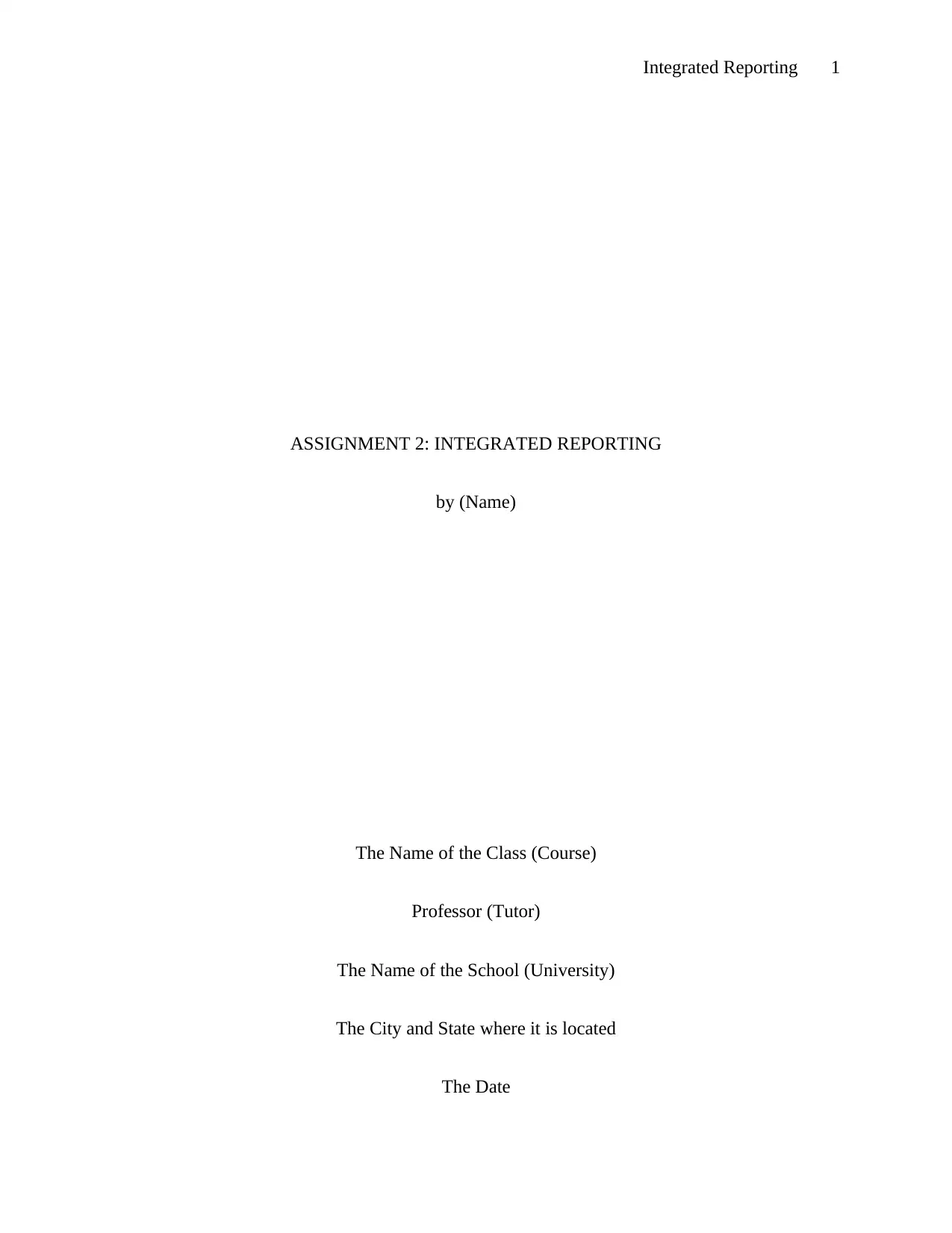
Integrated Reporting 1
ASSIGNMENT 2: INTEGRATED REPORTING
by (Name)
The Name of the Class (Course)
Professor (Tutor)
The Name of the School (University)
The City and State where it is located
The Date
ASSIGNMENT 2: INTEGRATED REPORTING
by (Name)
The Name of the Class (Course)
Professor (Tutor)
The Name of the School (University)
The City and State where it is located
The Date
Paraphrase This Document
Need a fresh take? Get an instant paraphrase of this document with our AI Paraphraser
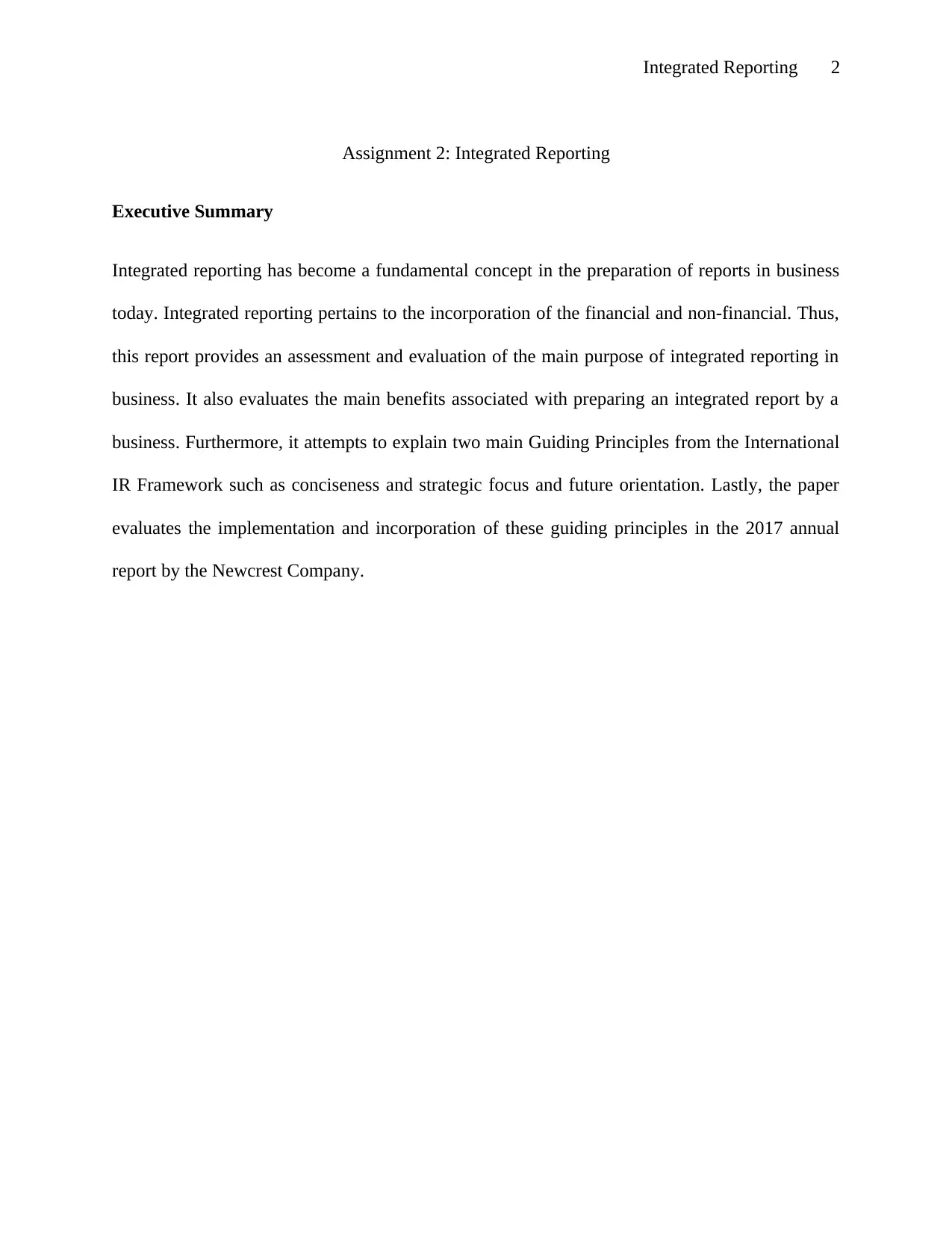
Integrated Reporting 2
Assignment 2: Integrated Reporting
Executive Summary
Integrated reporting has become a fundamental concept in the preparation of reports in business
today. Integrated reporting pertains to the incorporation of the financial and non-financial. Thus,
this report provides an assessment and evaluation of the main purpose of integrated reporting in
business. It also evaluates the main benefits associated with preparing an integrated report by a
business. Furthermore, it attempts to explain two main Guiding Principles from the International
IR Framework such as conciseness and strategic focus and future orientation. Lastly, the paper
evaluates the implementation and incorporation of these guiding principles in the 2017 annual
report by the Newcrest Company.
Assignment 2: Integrated Reporting
Executive Summary
Integrated reporting has become a fundamental concept in the preparation of reports in business
today. Integrated reporting pertains to the incorporation of the financial and non-financial. Thus,
this report provides an assessment and evaluation of the main purpose of integrated reporting in
business. It also evaluates the main benefits associated with preparing an integrated report by a
business. Furthermore, it attempts to explain two main Guiding Principles from the International
IR Framework such as conciseness and strategic focus and future orientation. Lastly, the paper
evaluates the implementation and incorporation of these guiding principles in the 2017 annual
report by the Newcrest Company.
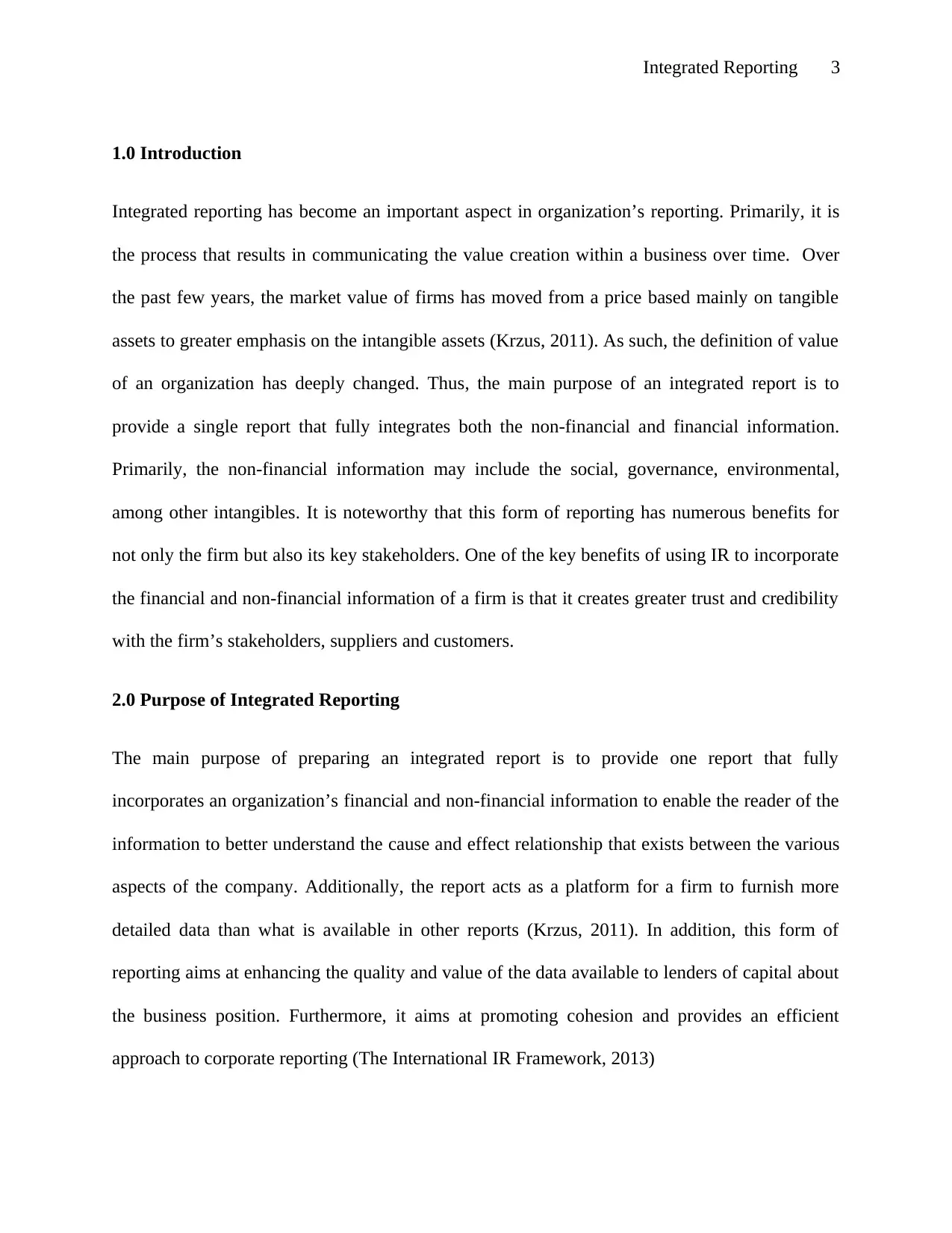
Integrated Reporting 3
1.0 Introduction
Integrated reporting has become an important aspect in organization’s reporting. Primarily, it is
the process that results in communicating the value creation within a business over time. Over
the past few years, the market value of firms has moved from a price based mainly on tangible
assets to greater emphasis on the intangible assets (Krzus, 2011). As such, the definition of value
of an organization has deeply changed. Thus, the main purpose of an integrated report is to
provide a single report that fully integrates both the non-financial and financial information.
Primarily, the non-financial information may include the social, governance, environmental,
among other intangibles. It is noteworthy that this form of reporting has numerous benefits for
not only the firm but also its key stakeholders. One of the key benefits of using IR to incorporate
the financial and non-financial information of a firm is that it creates greater trust and credibility
with the firm’s stakeholders, suppliers and customers.
2.0 Purpose of Integrated Reporting
The main purpose of preparing an integrated report is to provide one report that fully
incorporates an organization’s financial and non-financial information to enable the reader of the
information to better understand the cause and effect relationship that exists between the various
aspects of the company. Additionally, the report acts as a platform for a firm to furnish more
detailed data than what is available in other reports (Krzus, 2011). In addition, this form of
reporting aims at enhancing the quality and value of the data available to lenders of capital about
the business position. Furthermore, it aims at promoting cohesion and provides an efficient
approach to corporate reporting (The International IR Framework, 2013)
1.0 Introduction
Integrated reporting has become an important aspect in organization’s reporting. Primarily, it is
the process that results in communicating the value creation within a business over time. Over
the past few years, the market value of firms has moved from a price based mainly on tangible
assets to greater emphasis on the intangible assets (Krzus, 2011). As such, the definition of value
of an organization has deeply changed. Thus, the main purpose of an integrated report is to
provide a single report that fully integrates both the non-financial and financial information.
Primarily, the non-financial information may include the social, governance, environmental,
among other intangibles. It is noteworthy that this form of reporting has numerous benefits for
not only the firm but also its key stakeholders. One of the key benefits of using IR to incorporate
the financial and non-financial information of a firm is that it creates greater trust and credibility
with the firm’s stakeholders, suppliers and customers.
2.0 Purpose of Integrated Reporting
The main purpose of preparing an integrated report is to provide one report that fully
incorporates an organization’s financial and non-financial information to enable the reader of the
information to better understand the cause and effect relationship that exists between the various
aspects of the company. Additionally, the report acts as a platform for a firm to furnish more
detailed data than what is available in other reports (Krzus, 2011). In addition, this form of
reporting aims at enhancing the quality and value of the data available to lenders of capital about
the business position. Furthermore, it aims at promoting cohesion and provides an efficient
approach to corporate reporting (The International IR Framework, 2013)
⊘ This is a preview!⊘
Do you want full access?
Subscribe today to unlock all pages.

Trusted by 1+ million students worldwide
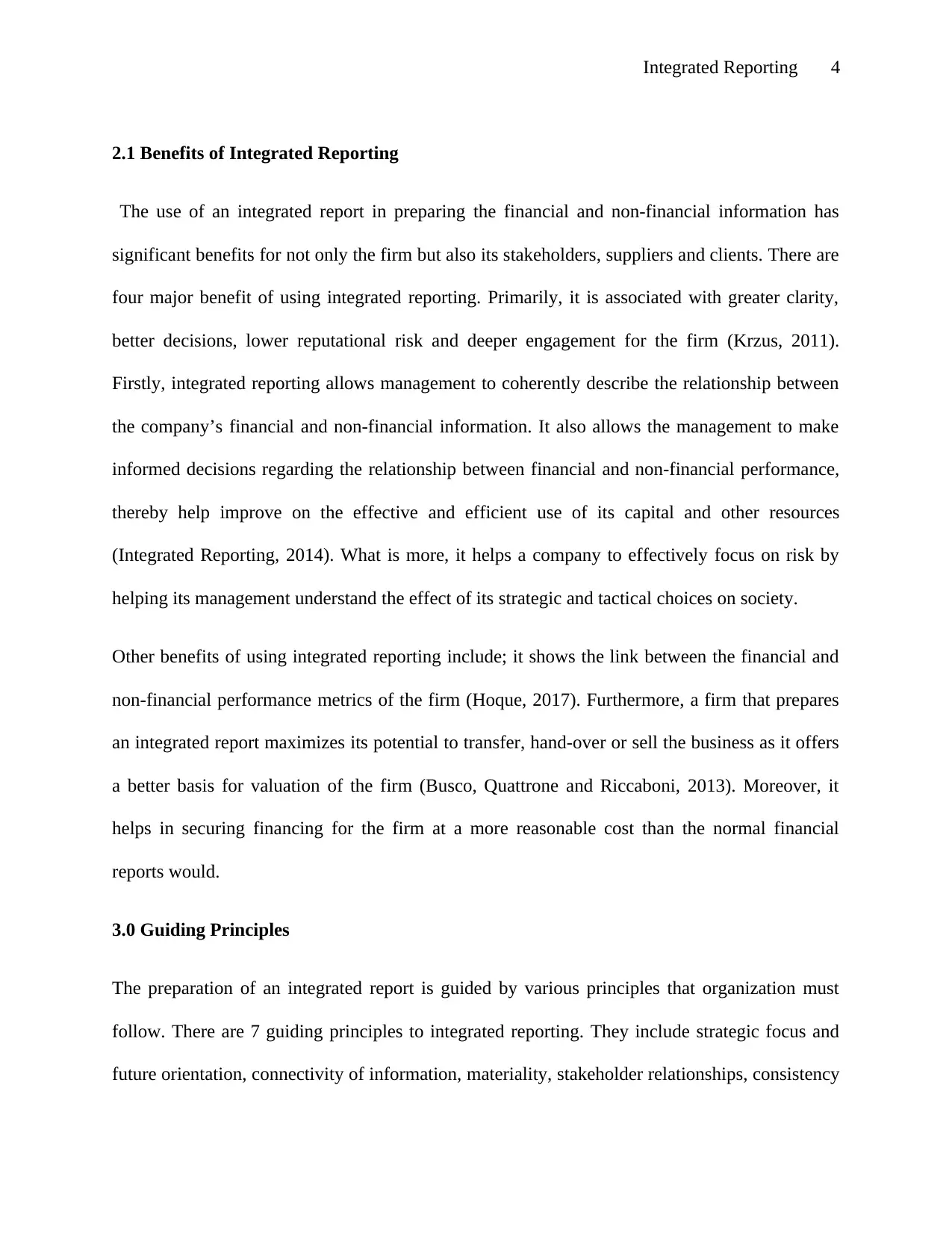
Integrated Reporting 4
2.1 Benefits of Integrated Reporting
The use of an integrated report in preparing the financial and non-financial information has
significant benefits for not only the firm but also its stakeholders, suppliers and clients. There are
four major benefit of using integrated reporting. Primarily, it is associated with greater clarity,
better decisions, lower reputational risk and deeper engagement for the firm (Krzus, 2011).
Firstly, integrated reporting allows management to coherently describe the relationship between
the company’s financial and non-financial information. It also allows the management to make
informed decisions regarding the relationship between financial and non-financial performance,
thereby help improve on the effective and efficient use of its capital and other resources
(Integrated Reporting, 2014). What is more, it helps a company to effectively focus on risk by
helping its management understand the effect of its strategic and tactical choices on society.
Other benefits of using integrated reporting include; it shows the link between the financial and
non-financial performance metrics of the firm (Hoque, 2017). Furthermore, a firm that prepares
an integrated report maximizes its potential to transfer, hand-over or sell the business as it offers
a better basis for valuation of the firm (Busco, Quattrone and Riccaboni, 2013). Moreover, it
helps in securing financing for the firm at a more reasonable cost than the normal financial
reports would.
3.0 Guiding Principles
The preparation of an integrated report is guided by various principles that organization must
follow. There are 7 guiding principles to integrated reporting. They include strategic focus and
future orientation, connectivity of information, materiality, stakeholder relationships, consistency
2.1 Benefits of Integrated Reporting
The use of an integrated report in preparing the financial and non-financial information has
significant benefits for not only the firm but also its stakeholders, suppliers and clients. There are
four major benefit of using integrated reporting. Primarily, it is associated with greater clarity,
better decisions, lower reputational risk and deeper engagement for the firm (Krzus, 2011).
Firstly, integrated reporting allows management to coherently describe the relationship between
the company’s financial and non-financial information. It also allows the management to make
informed decisions regarding the relationship between financial and non-financial performance,
thereby help improve on the effective and efficient use of its capital and other resources
(Integrated Reporting, 2014). What is more, it helps a company to effectively focus on risk by
helping its management understand the effect of its strategic and tactical choices on society.
Other benefits of using integrated reporting include; it shows the link between the financial and
non-financial performance metrics of the firm (Hoque, 2017). Furthermore, a firm that prepares
an integrated report maximizes its potential to transfer, hand-over or sell the business as it offers
a better basis for valuation of the firm (Busco, Quattrone and Riccaboni, 2013). Moreover, it
helps in securing financing for the firm at a more reasonable cost than the normal financial
reports would.
3.0 Guiding Principles
The preparation of an integrated report is guided by various principles that organization must
follow. There are 7 guiding principles to integrated reporting. They include strategic focus and
future orientation, connectivity of information, materiality, stakeholder relationships, consistency
Paraphrase This Document
Need a fresh take? Get an instant paraphrase of this document with our AI Paraphraser
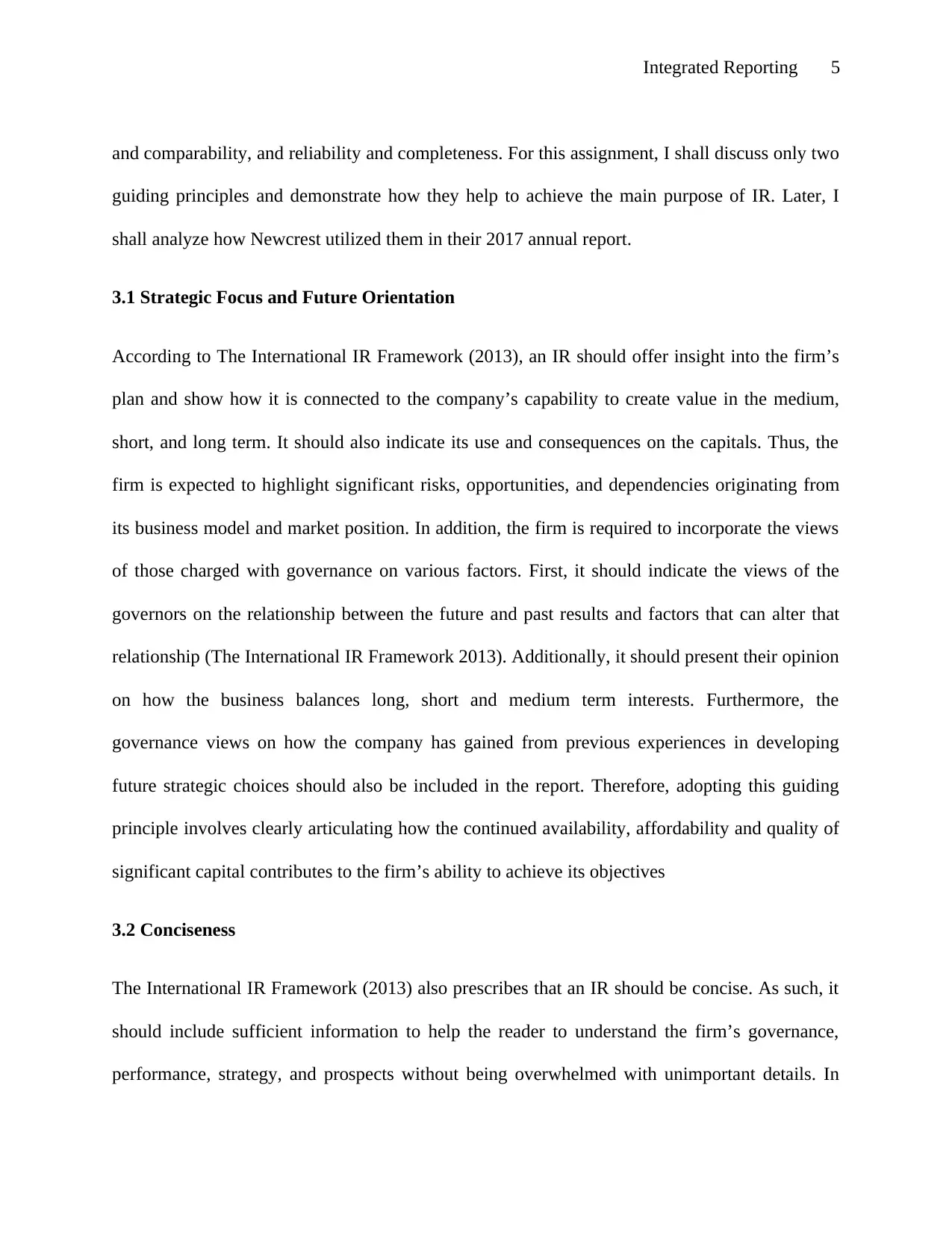
Integrated Reporting 5
and comparability, and reliability and completeness. For this assignment, I shall discuss only two
guiding principles and demonstrate how they help to achieve the main purpose of IR. Later, I
shall analyze how Newcrest utilized them in their 2017 annual report.
3.1 Strategic Focus and Future Orientation
According to The International IR Framework (2013), an IR should offer insight into the firm’s
plan and show how it is connected to the company’s capability to create value in the medium,
short, and long term. It should also indicate its use and consequences on the capitals. Thus, the
firm is expected to highlight significant risks, opportunities, and dependencies originating from
its business model and market position. In addition, the firm is required to incorporate the views
of those charged with governance on various factors. First, it should indicate the views of the
governors on the relationship between the future and past results and factors that can alter that
relationship (The International IR Framework 2013). Additionally, it should present their opinion
on how the business balances long, short and medium term interests. Furthermore, the
governance views on how the company has gained from previous experiences in developing
future strategic choices should also be included in the report. Therefore, adopting this guiding
principle involves clearly articulating how the continued availability, affordability and quality of
significant capital contributes to the firm’s ability to achieve its objectives
3.2 Conciseness
The International IR Framework (2013) also prescribes that an IR should be concise. As such, it
should include sufficient information to help the reader to understand the firm’s governance,
performance, strategy, and prospects without being overwhelmed with unimportant details. In
and comparability, and reliability and completeness. For this assignment, I shall discuss only two
guiding principles and demonstrate how they help to achieve the main purpose of IR. Later, I
shall analyze how Newcrest utilized them in their 2017 annual report.
3.1 Strategic Focus and Future Orientation
According to The International IR Framework (2013), an IR should offer insight into the firm’s
plan and show how it is connected to the company’s capability to create value in the medium,
short, and long term. It should also indicate its use and consequences on the capitals. Thus, the
firm is expected to highlight significant risks, opportunities, and dependencies originating from
its business model and market position. In addition, the firm is required to incorporate the views
of those charged with governance on various factors. First, it should indicate the views of the
governors on the relationship between the future and past results and factors that can alter that
relationship (The International IR Framework 2013). Additionally, it should present their opinion
on how the business balances long, short and medium term interests. Furthermore, the
governance views on how the company has gained from previous experiences in developing
future strategic choices should also be included in the report. Therefore, adopting this guiding
principle involves clearly articulating how the continued availability, affordability and quality of
significant capital contributes to the firm’s ability to achieve its objectives
3.2 Conciseness
The International IR Framework (2013) also prescribes that an IR should be concise. As such, it
should include sufficient information to help the reader to understand the firm’s governance,
performance, strategy, and prospects without being overwhelmed with unimportant details. In
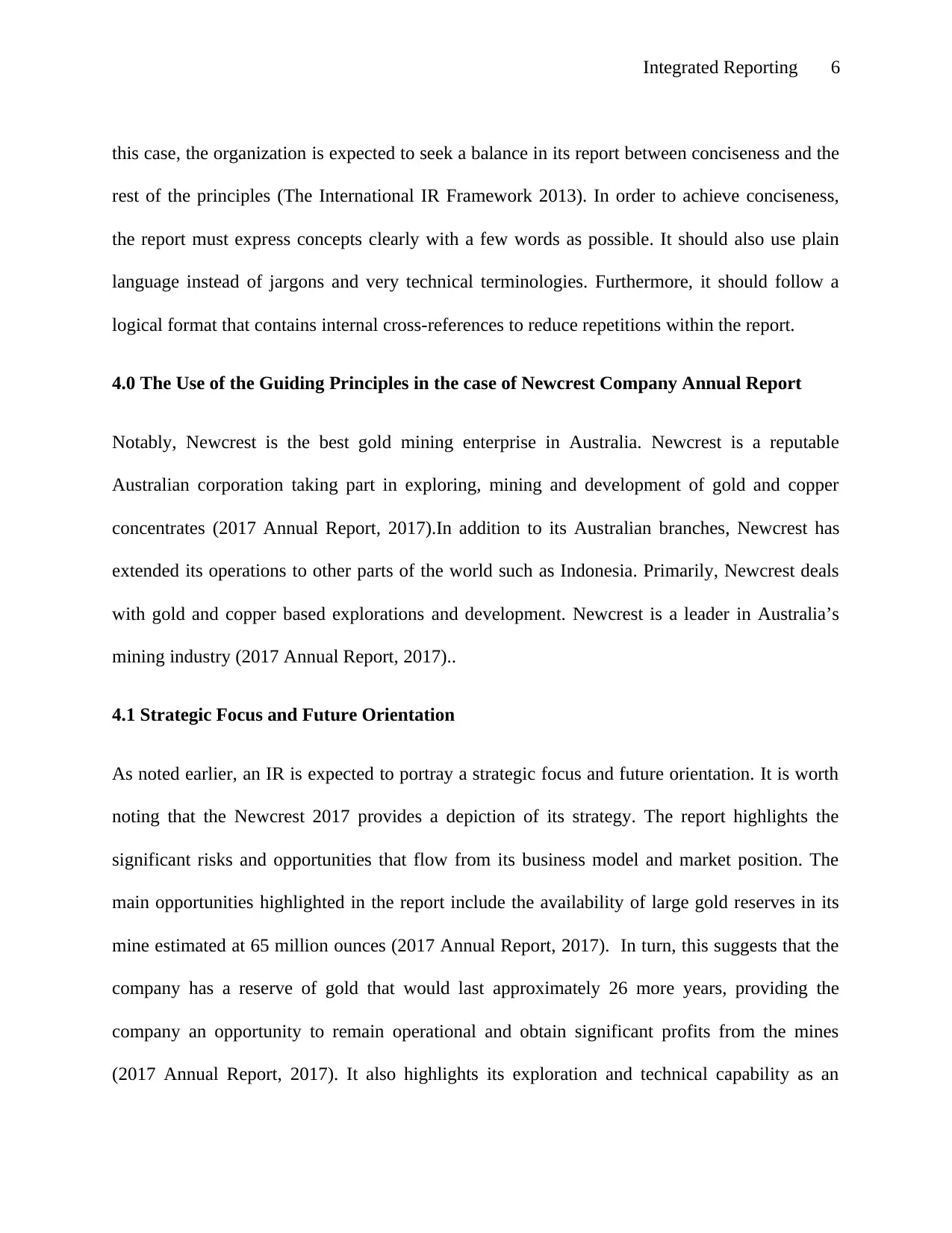
Integrated Reporting 6
this case, the organization is expected to seek a balance in its report between conciseness and the
rest of the principles (The International IR Framework 2013). In order to achieve conciseness,
the report must express concepts clearly with a few words as possible. It should also use plain
language instead of jargons and very technical terminologies. Furthermore, it should follow a
logical format that contains internal cross-references to reduce repetitions within the report.
4.0 The Use of the Guiding Principles in the case of Newcrest Company Annual Report
Notably, Newcrest is the best gold mining enterprise in Australia. Newcrest is a reputable
Australian corporation taking part in exploring, mining and development of gold and copper
concentrates (2017 Annual Report, 2017).In addition to its Australian branches, Newcrest has
extended its operations to other parts of the world such as Indonesia. Primarily, Newcrest deals
with gold and copper based explorations and development. Newcrest is a leader in Australia’s
mining industry (2017 Annual Report, 2017)..
4.1 Strategic Focus and Future Orientation
As noted earlier, an IR is expected to portray a strategic focus and future orientation. It is worth
noting that the Newcrest 2017 provides a depiction of its strategy. The report highlights the
significant risks and opportunities that flow from its business model and market position. The
main opportunities highlighted in the report include the availability of large gold reserves in its
mine estimated at 65 million ounces (2017 Annual Report, 2017). In turn, this suggests that the
company has a reserve of gold that would last approximately 26 more years, providing the
company an opportunity to remain operational and obtain significant profits from the mines
(2017 Annual Report, 2017). It also highlights its exploration and technical capability as an
this case, the organization is expected to seek a balance in its report between conciseness and the
rest of the principles (The International IR Framework 2013). In order to achieve conciseness,
the report must express concepts clearly with a few words as possible. It should also use plain
language instead of jargons and very technical terminologies. Furthermore, it should follow a
logical format that contains internal cross-references to reduce repetitions within the report.
4.0 The Use of the Guiding Principles in the case of Newcrest Company Annual Report
Notably, Newcrest is the best gold mining enterprise in Australia. Newcrest is a reputable
Australian corporation taking part in exploring, mining and development of gold and copper
concentrates (2017 Annual Report, 2017).In addition to its Australian branches, Newcrest has
extended its operations to other parts of the world such as Indonesia. Primarily, Newcrest deals
with gold and copper based explorations and development. Newcrest is a leader in Australia’s
mining industry (2017 Annual Report, 2017)..
4.1 Strategic Focus and Future Orientation
As noted earlier, an IR is expected to portray a strategic focus and future orientation. It is worth
noting that the Newcrest 2017 provides a depiction of its strategy. The report highlights the
significant risks and opportunities that flow from its business model and market position. The
main opportunities highlighted in the report include the availability of large gold reserves in its
mine estimated at 65 million ounces (2017 Annual Report, 2017). In turn, this suggests that the
company has a reserve of gold that would last approximately 26 more years, providing the
company an opportunity to remain operational and obtain significant profits from the mines
(2017 Annual Report, 2017). It also highlights its exploration and technical capability as an
⊘ This is a preview!⊘
Do you want full access?
Subscribe today to unlock all pages.

Trusted by 1+ million students worldwide
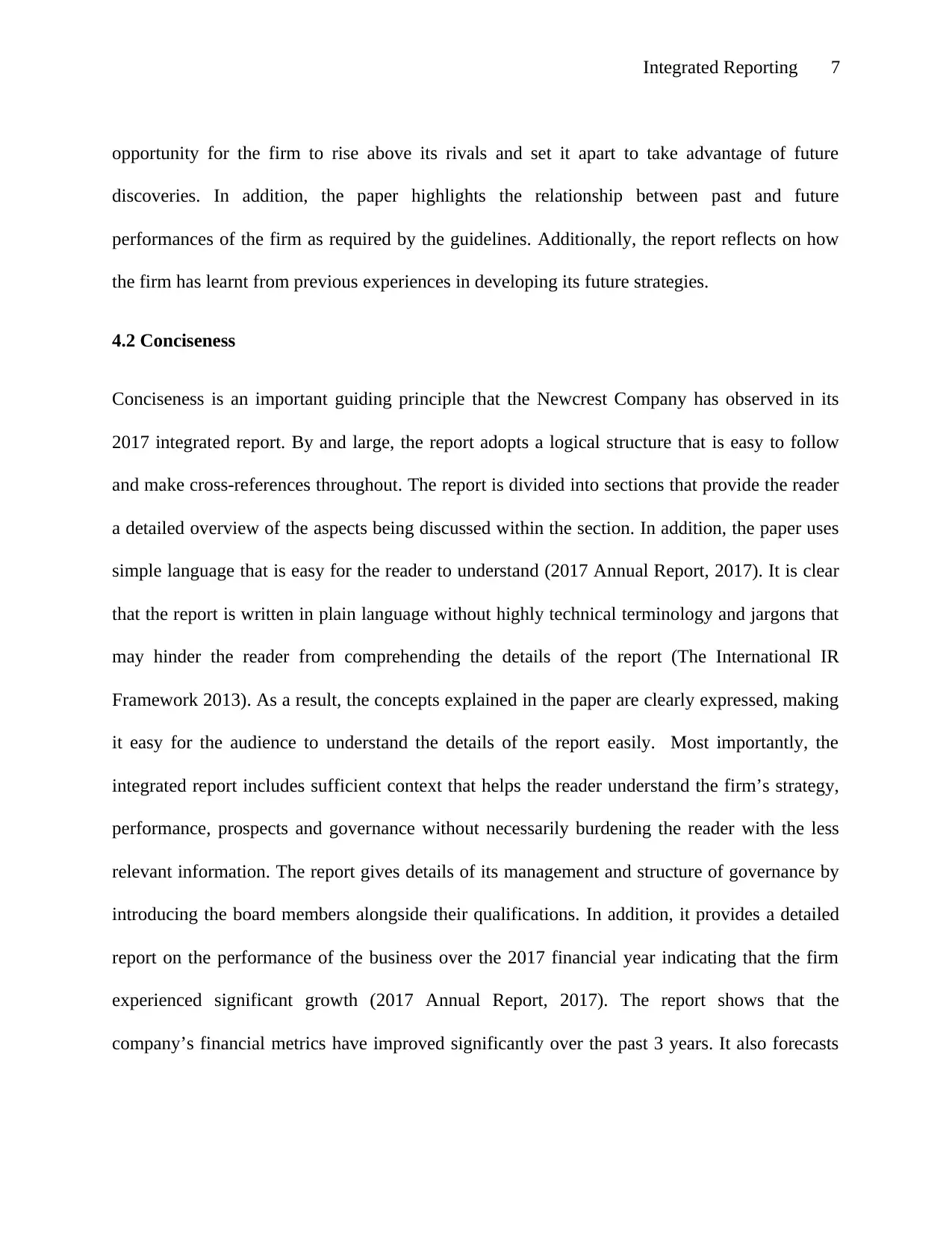
Integrated Reporting 7
opportunity for the firm to rise above its rivals and set it apart to take advantage of future
discoveries. In addition, the paper highlights the relationship between past and future
performances of the firm as required by the guidelines. Additionally, the report reflects on how
the firm has learnt from previous experiences in developing its future strategies.
4.2 Conciseness
Conciseness is an important guiding principle that the Newcrest Company has observed in its
2017 integrated report. By and large, the report adopts a logical structure that is easy to follow
and make cross-references throughout. The report is divided into sections that provide the reader
a detailed overview of the aspects being discussed within the section. In addition, the paper uses
simple language that is easy for the reader to understand (2017 Annual Report, 2017). It is clear
that the report is written in plain language without highly technical terminology and jargons that
may hinder the reader from comprehending the details of the report (The International IR
Framework 2013). As a result, the concepts explained in the paper are clearly expressed, making
it easy for the audience to understand the details of the report easily. Most importantly, the
integrated report includes sufficient context that helps the reader understand the firm’s strategy,
performance, prospects and governance without necessarily burdening the reader with the less
relevant information. The report gives details of its management and structure of governance by
introducing the board members alongside their qualifications. In addition, it provides a detailed
report on the performance of the business over the 2017 financial year indicating that the firm
experienced significant growth (2017 Annual Report, 2017). The report shows that the
company’s financial metrics have improved significantly over the past 3 years. It also forecasts
opportunity for the firm to rise above its rivals and set it apart to take advantage of future
discoveries. In addition, the paper highlights the relationship between past and future
performances of the firm as required by the guidelines. Additionally, the report reflects on how
the firm has learnt from previous experiences in developing its future strategies.
4.2 Conciseness
Conciseness is an important guiding principle that the Newcrest Company has observed in its
2017 integrated report. By and large, the report adopts a logical structure that is easy to follow
and make cross-references throughout. The report is divided into sections that provide the reader
a detailed overview of the aspects being discussed within the section. In addition, the paper uses
simple language that is easy for the reader to understand (2017 Annual Report, 2017). It is clear
that the report is written in plain language without highly technical terminology and jargons that
may hinder the reader from comprehending the details of the report (The International IR
Framework 2013). As a result, the concepts explained in the paper are clearly expressed, making
it easy for the audience to understand the details of the report easily. Most importantly, the
integrated report includes sufficient context that helps the reader understand the firm’s strategy,
performance, prospects and governance without necessarily burdening the reader with the less
relevant information. The report gives details of its management and structure of governance by
introducing the board members alongside their qualifications. In addition, it provides a detailed
report on the performance of the business over the 2017 financial year indicating that the firm
experienced significant growth (2017 Annual Report, 2017). The report shows that the
company’s financial metrics have improved significantly over the past 3 years. It also forecasts
Paraphrase This Document
Need a fresh take? Get an instant paraphrase of this document with our AI Paraphraser
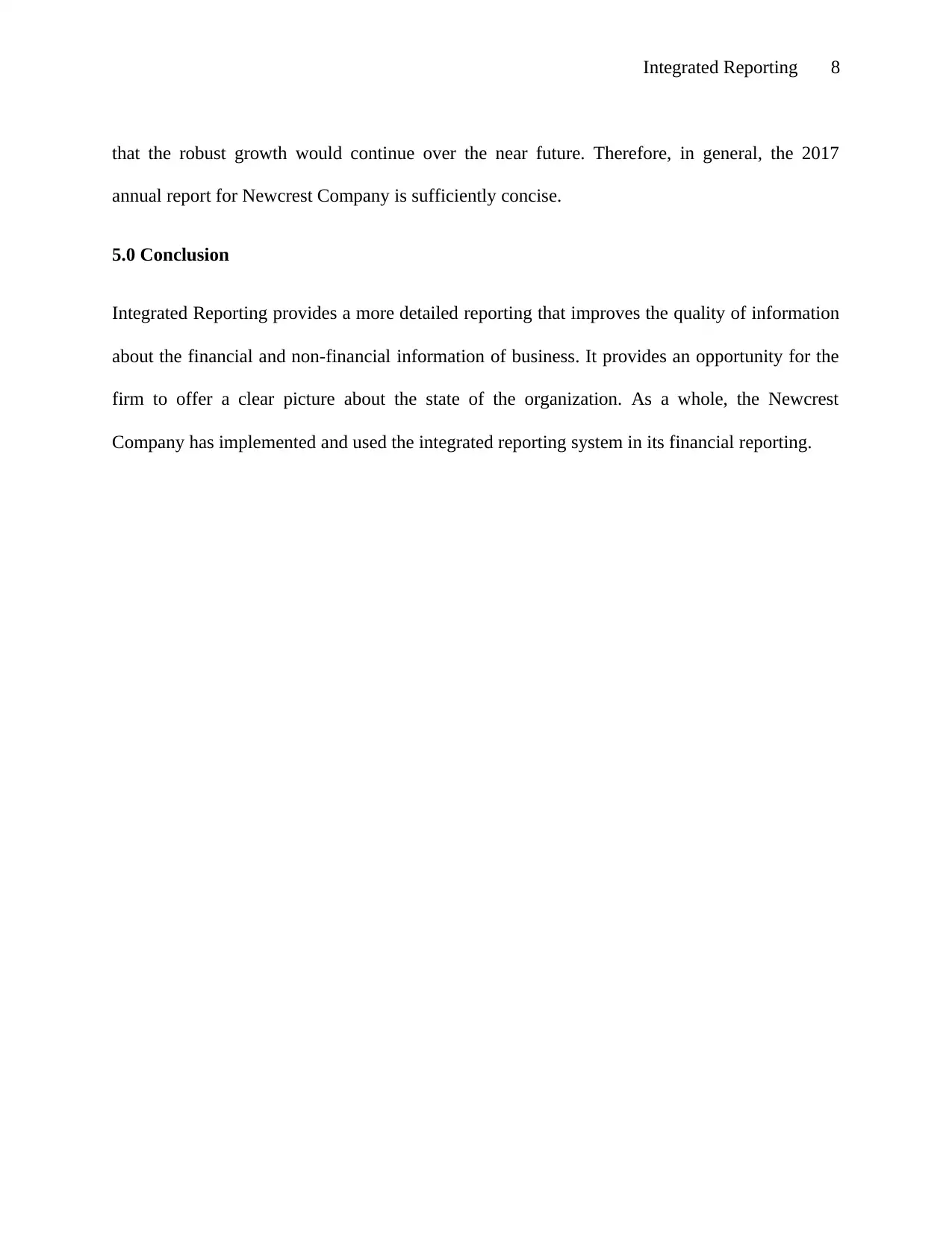
Integrated Reporting 8
that the robust growth would continue over the near future. Therefore, in general, the 2017
annual report for Newcrest Company is sufficiently concise.
5.0 Conclusion
Integrated Reporting provides a more detailed reporting that improves the quality of information
about the financial and non-financial information of business. It provides an opportunity for the
firm to offer a clear picture about the state of the organization. As a whole, the Newcrest
Company has implemented and used the integrated reporting system in its financial reporting.
that the robust growth would continue over the near future. Therefore, in general, the 2017
annual report for Newcrest Company is sufficiently concise.
5.0 Conclusion
Integrated Reporting provides a more detailed reporting that improves the quality of information
about the financial and non-financial information of business. It provides an opportunity for the
firm to offer a clear picture about the state of the organization. As a whole, the Newcrest
Company has implemented and used the integrated reporting system in its financial reporting.
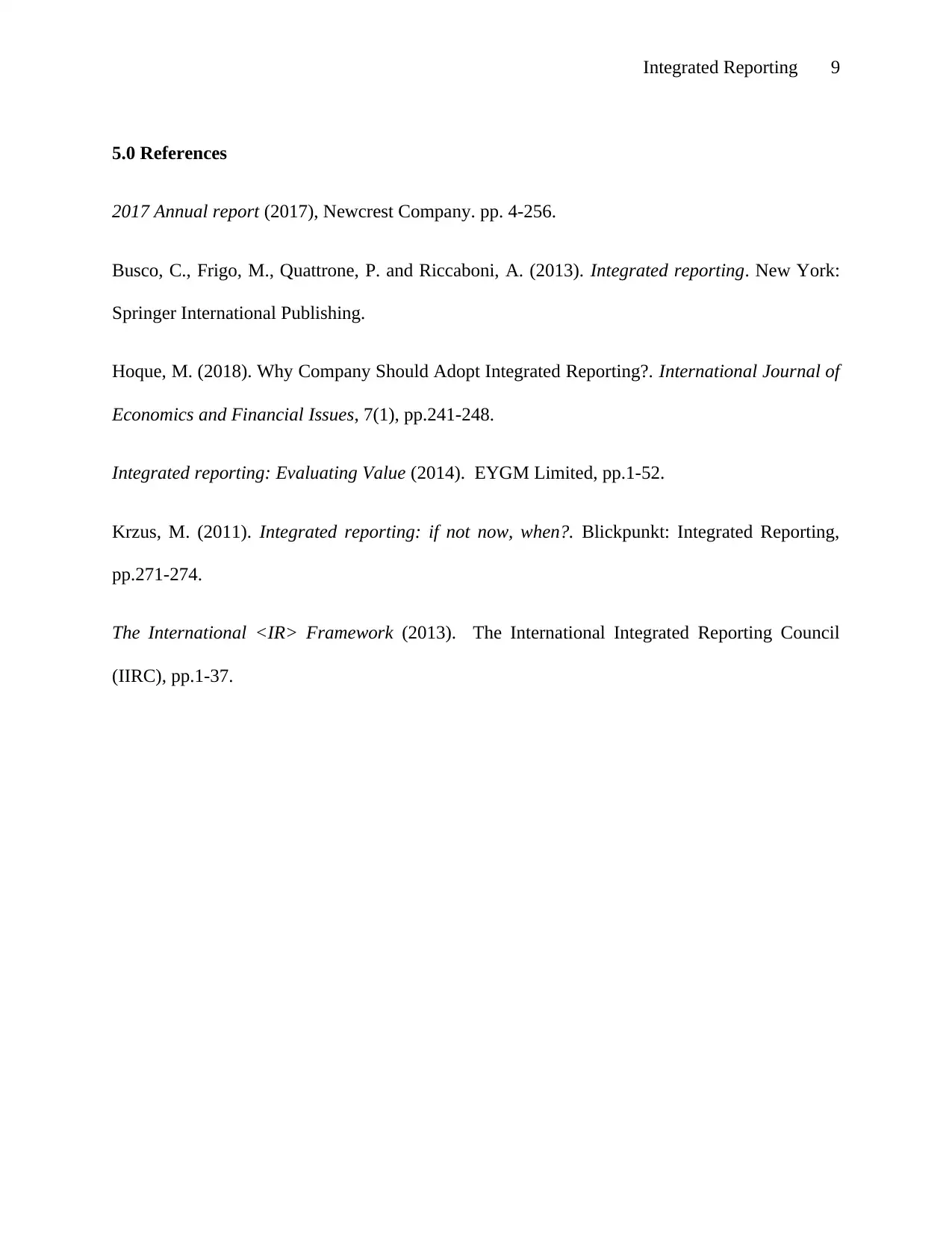
Integrated Reporting 9
5.0 References
2017 Annual report (2017), Newcrest Company. pp. 4-256.
Busco, C., Frigo, M., Quattrone, P. and Riccaboni, A. (2013). Integrated reporting. New York:
Springer International Publishing.
Hoque, M. (2018). Why Company Should Adopt Integrated Reporting?. International Journal of
Economics and Financial Issues, 7(1), pp.241-248.
Integrated reporting: Evaluating Value (2014). EYGM Limited, pp.1-52.
Krzus, M. (2011). Integrated reporting: if not now, when?. Blickpunkt: Integrated Reporting,
pp.271-274.
The International <IR> Framework (2013). The International Integrated Reporting Council
(IIRC), pp.1-37.
5.0 References
2017 Annual report (2017), Newcrest Company. pp. 4-256.
Busco, C., Frigo, M., Quattrone, P. and Riccaboni, A. (2013). Integrated reporting. New York:
Springer International Publishing.
Hoque, M. (2018). Why Company Should Adopt Integrated Reporting?. International Journal of
Economics and Financial Issues, 7(1), pp.241-248.
Integrated reporting: Evaluating Value (2014). EYGM Limited, pp.1-52.
Krzus, M. (2011). Integrated reporting: if not now, when?. Blickpunkt: Integrated Reporting,
pp.271-274.
The International <IR> Framework (2013). The International Integrated Reporting Council
(IIRC), pp.1-37.
⊘ This is a preview!⊘
Do you want full access?
Subscribe today to unlock all pages.

Trusted by 1+ million students worldwide
1 out of 9
Related Documents
Your All-in-One AI-Powered Toolkit for Academic Success.
+13062052269
info@desklib.com
Available 24*7 on WhatsApp / Email
![[object Object]](/_next/static/media/star-bottom.7253800d.svg)
Unlock your academic potential
Copyright © 2020–2025 A2Z Services. All Rights Reserved. Developed and managed by ZUCOL.





